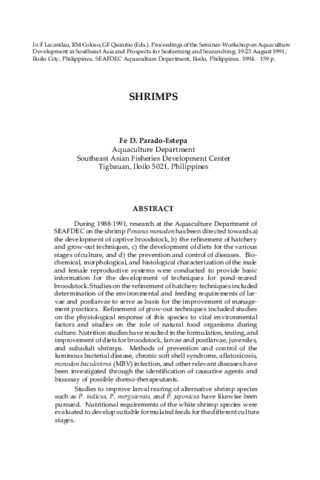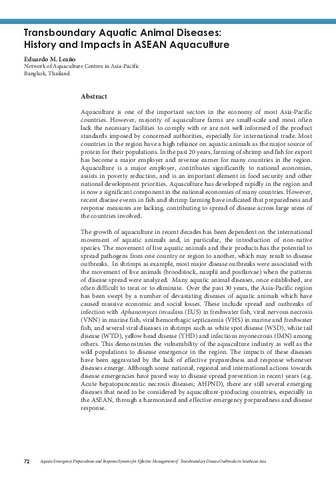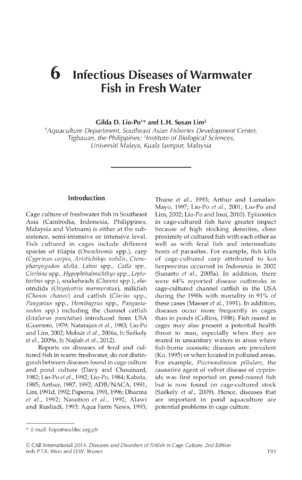Shrimps
| dc.contributor.author | Parado-Estepa, Fe D. | |
| dc.contributor.editor | Lacanilao, F. | |
| dc.contributor.editor | Coloso, Relicardo M. | |
| dc.contributor.editor | Quinitio, Gerald F. | |
| dc.date.accessioned | 2011-05-20T06:23:59Z | |
| dc.date.available | 2011-05-20T06:23:59Z | |
| dc.date.issued | 1994 | |
| dc.identifier.citation | Parado-Estepa, F. D. (1994). Shrimps. In F. Lacanilao, R. M. Coloso, & G. F. Quinitio (Eds.), Proceedings of the Seminar-Workshop on Aquaculture Development in Southeast Asia and Prospects for Seafarming and Searanching; 19-23 August 1991; Iloilo City, Philippines. (pp. 32-39). Tigbauan, Iloilo, Philippines: Aquaculture Department, Southeast Asian Fisheries Development Center. | en |
| dc.identifier.isbn | 971851127X | |
| dc.identifier.uri | http://hdl.handle.net/10862/39 | |
| dc.description.abstract | During 1988-1991, research at the Aquaculture Department of SEAFDEC on the shrimp Penaeus monodon has been directed towards a) the development of captive broodstock, b) the refinement of hatchery and grow-out techniques, c) the development of diets for the various stages of culture, and d) the prevention and control of diseases. Biochemical, morphological, and histological characterization of the male and female reproductive systems were conducted to provide basic information for the development of techniques for pond-reared broodstock. Studies on the refinement of hatchery techniques included determination of the environmental and feeding requirements of larvae and postlarvae to serve as basis for the improvement of management practices. Refinement of grow-out techniques included studies on the physiological response of this species to vital environmental factors and studies on the role of natural food organisms during culture. Nutrition studies have resulted in the formulation, testing, and improvement of diets for broodstock, larvae and postlarvae, juveniles, and subadult shrimps. Methods of prevention and control of the luminous bacterial disease, chronic soft shell syndrome, aflatoxicosis, monodon baculovirus (MBV) infection, and other relevant diseases have been investigated through the identification of causative agents and bioassay of possible chemo-therapeutants. Studies to improve larval rearing of alternative shrimp species such as P. indicus, P. merguiensis, and P. japonicus have likewise been pursued. Nutritional requirements of the white shrimp species were evaluated to develop suitable formulated feeds for the different culture stages. | en |
| dc.language.iso | en | en |
| dc.publisher | Aquaculture Department, Southeast Asian Fisheries Development Center | en |
| dc.subject | Penaeus monodon | en |
| dc.subject | Philippines | en |
| dc.title | Shrimps | en |
| dc.type | Conference paper | en |
| dc.citation.spage | 32 | |
| dc.citation.epage | 39 | |
| dc.citation.conferenceTitle | Seminar-Workshop on Aquaculture Development in Southeast Asia and Prospects for Seafarming and Searanching; 19-23 August 1991; Iloilo City, Philippines. | en |
| dc.subject.asfa | testes | en |
| dc.subject.asfa | diet | en |
| dc.subject.asfa | cultured organisms | en |
| dc.subject.asfa | shrimp culture | en |
| dc.subject.asfa | animal reproductive organs | en |
| dc.subject.asfa | bacterial diseases | en |
| dc.subject.asfa | husbandry diseases | en |
| dc.subject.asfa | disease control | en |
| dc.subject.asfa | larvae | en |
| dc.subject.asfa | pond culture | en |
| dc.subject.asfa | nutritional requirements | en |
| dc.subject.asfa | disease prophylaxis | en |
| dc.subject.asfa | ovaries | en |
| dc.subject.asfa | breeding stock | en |
| dc.subject.asfa | aquaculture techniques | en |
| dc.subject.scientificName | Penaeus monodon | en |
| dc.subject.scientificName | Fenneropenaeus merguiensis | en |
| dc.subject.scientificName | Fenneropenaeus indicus | en |
| dc.subject.scientificName | Marsupenaeus japonicus | en |
このアイテムのファイル
このアイテムは次のコレクションに所属しています
-
ADSEA '91 [21]
Proceedings of the Seminar-Workshop on Aquaculture Development in Southeast Asia and Prospects for Seafarming and Searanching, 19-23 August 1991, Iloilo City, Philippines





